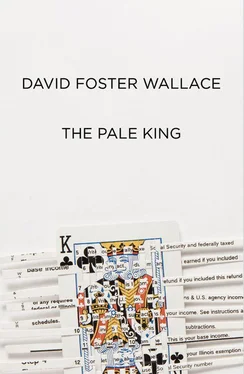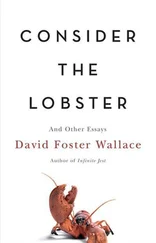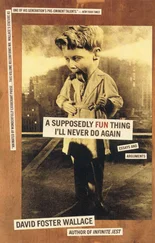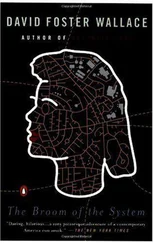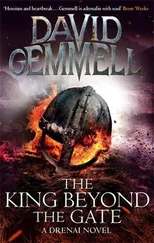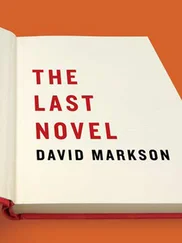David Wallace - The Pale King - An Unfinished Novel
Здесь есть возможность читать онлайн «David Wallace - The Pale King - An Unfinished Novel» весь текст электронной книги совершенно бесплатно (целиком полную версию без сокращений). В некоторых случаях можно слушать аудио, скачать через торрент в формате fb2 и присутствует краткое содержание. Год выпуска: 2011, Издательство: Little, Brown & Company, Жанр: Современная проза, на английском языке. Описание произведения, (предисловие) а так же отзывы посетителей доступны на портале библиотеки ЛибКат.
- Название:The Pale King: An Unfinished Novel
- Автор:
- Издательство:Little, Brown & Company
- Жанр:
- Год:2011
- ISBN:нет данных
- Рейтинг книги:3 / 5. Голосов: 1
-
Избранное:Добавить в избранное
- Отзывы:
-
Ваша оценка:
- 60
- 1
- 2
- 3
- 4
- 5
The Pale King: An Unfinished Novel: краткое содержание, описание и аннотация
Предлагаем к чтению аннотацию, описание, краткое содержание или предисловие (зависит от того, что написал сам автор книги «The Pale King: An Unfinished Novel»). Если вы не нашли необходимую информацию о книге — напишите в комментариях, мы постараемся отыскать её.
The Pale King
The Pale King: An Unfinished Novel — читать онлайн бесплатно полную книгу (весь текст) целиком
Ниже представлен текст книги, разбитый по страницам. Система сохранения места последней прочитанной страницы, позволяет с удобством читать онлайн бесплатно книгу «The Pale King: An Unfinished Novel», без необходимости каждый раз заново искать на чём Вы остановились. Поставьте закладку, и сможете в любой момент перейти на страницу, на которой закончили чтение.
Интервал:
Закладка:
4 I no longer have this original two-page Form 141-PO, which vanished into the maw of the REC’s Personnel and Internal Control Systems Problem Resolution filing systems during the whole eventual swivet and comedy of errors surrounding my initial misassignment to an Immersive Exams Pod, the story of which unfolds in full pathetic, ur-bureaucratic detail below.
5 N.B.: With possible competition only from East St. Louis, Peoria and Joliet are well-known as the two grimmest, most blighted and depressed old factory cities in Illinois*, which fact turns out not to be a coincidence, since it affords statistically verifiable savings to the Service in terms of both facilities and labor. The location of most Regional HQs, RECs, and Service Centers in blighted and/or devitalized cities, which is traceable all the way back to the Service’s big reorganization and decentralization after the King Commission’s report to Congress in 1952, is just one sign of the deep pro-business and — bottom-line philosophies beginning to gather force in the Service as early as the Nixon administration.
* As part of the overall relevant context, be advised that Illinois’s five largest cities and metro areas by population (excluding Chicago, which is more like its own galaxy) c. 1985 were, in descending order, Rockford, Peoria, Springfield, Joliet, and Decatur.
6 I do, by the way, still possess this letter, which for legal reasons I am told I cannot reproduce more than one single fair-use sentence of, for ‘general flavor,’ the sentence I’ve chosen being from the second immaculately copperplate-handwritten paragraph; to wit: ‘He will be given only a small job to begin with, and it will be his business to work his way up by diligence and attentiveness,’ in the margin next to which the unnamed addressee of this letter had absently jotted either ‘HA!’ or ‘HAH!’ depending on how one tried to parse the spiky and almost indecipherable hand of someone for whom a ‘quick cocktail before supper’ involved a sixteen-ounce tumbler and no ice.
7 This was, keep in mind, the tail end of the era of mainframe computers, tape- and card-based data storage, & c., which now seems almost Flintstonianly remote.
8 However puerile it seems now, I know that I sometimes felt an irrational anxiety about the possibility that the recent unpleasantness at school might have found its way into some shadowily comprehensive data retrieval system to which the IRS was somehow linked, and that some kind of bell or siren would suddenly sound when I presented at the counter for my ID and badge, and so on… an irrational fear that I knew was irrational and so did not admit fully into my consciousness, though at the same time I know that I spent at least some of the interminable time aboard the bus to Peoria idly constructing emergency plans and scenarios for how, if and when the bell or siren sounded, I might avoid returning home to Philo the same day I’d left and facing whoever it was who opened the door to my knock and saw me there on the home’s filthy screen porch with my bags and dispatch case — at some moments I know that the unconscious anxiety consisted only of envisioning the expression on the face of whatever immediate relative opened the door, saw me, and opened his mouth to say something, at which time I became aware of the fact that I was having anxious fantasies and waved them away on the bus ride, returning to the unbelievably insipid book I’d been presented with as a ‘gift’ by my family, their idea of useful wisdom and support, this ‘gift’ presented to me at supper on the evening before my departure (which special farewell supper, by the way, had consisted of [a] leftovers and [b] steamed ears of corn that I had just had my braces tightened and couldn’t even have hoped to try to eat), after first being told to open the gift very carefully so that the wrapping paper could be reused.
9 (plus, I’ll admit, a certain amount of slack relief at what seemed to be the opposite of bells/sirens and possible rejection for ethical unfitness or whatever my unconscious had conjured; I think I’d been more afraid than I’d acknowledged to myself)
10 This boy had also spent the first several minutes after I’d boarded and gotten settled staring wide-eyed at the condition of the side of my face, making no effort to hide or disguise the clinical interest with which little children stare, all of which I’d of course seen (and in some ways almost appreciated) out of the corner of my eye.
11 I.e., all these men with hats, which hats I would soon suspect and then outright learn were an Exam Division trademark (just as flat square shoulder-holsters for one’s pocket calculator were the signature accessory of Audits, earbuds and stylized tie clips were Systems, and so on) such that the REC’s group rooms, whether for rotes or immersives, all featured at least one wall with a peg-board of hooks for examiners’ hats, since individual hat racks or hooks screwed into the edge of one’s Tingle table created impediments for cart boys’ carts…
12 (e.g., having one character inform another of stuff they both actually already know, in order to get this information across to the reader — which I’ve always found irksome in the extreme, not to mention highly suspicious in a ‘nonfiction’ memoir, although it is true [if mysterious] that mass-market readers seem not to mind being jerked around this way)
13 N.B.: Some of this is more or less lifted from the packet of IRS orientation materials that new hires and transfers received at Intake & Processing; hence the somewhat dead, bureaucratic flavor, which I have elected not to jazz up or prettify.
14 I have, however, worked in relevant details that were obviously not in the official materials. The Rome debacle was not something the Service had any interest in publicizing, even internally; but it also figured prominently in the whole high-level struggle over the so-called ‘Initiative’ and its implementation. None of which I had any idea of or interest in on this first day, it goes without saying.
15 One of the pieces of freelance work I’d completed just before the fraternity-file idiocy blew up in everyone’s face had been the first two chapters of a rather likable but disorganized sociology major’s senior thesis on shopping malls as the modern functional analog of medieval cathedrals (with some of the parallels being downright striking), and I had no stomach left for shopping malls, even though they were often the only places anymore that had movie theaters, the grand old downtown palaces being now either shuttered or converted to Adult.
16 True, there had been silent rides aplenty with my own family, though the AM radio then was always playing Easy Listening music at high volume, which helped explain-slash-cover the absence of conversation.
17 GS-9 Chris Fogle would later explain (probably as I and whoever else was around rotated our hand in the air in the please-get-on-with-it way that almost everyone started involuntarily rotating their hand to convey whenever ‘Irrelevant’ Chris was on a roll) that the widening of Self-Storage Parkway had been stalled for over a year, first because a supplementary bond issue was being challenged in district court by a conservative Illinois citizens’ taxation watchdog group, and second because the extremely harsh regional winters and abrupt spring thaws that then so often refroze again a day later (all of which is true) caused whatever part of the new, freshly built SSP third lane that had not been treated with a special type of industrial sealant to heave and crack, and the courts had halted the previous year’s construction at just the point when this sealant was going to be applied with some kind of rare and very expensive piece of heavy machinery that had to be rented far in advance from a single specialty-distributor in either Wisconsin or Minnesota (I still have an actual sense-memory of the way my hand would begin rotating in the air, almost involuntarily, when Fogle started foundering in extraneous detail — he was unpopular out of all proportion to his character, which was actually decent and well-meaning to a fault; he was one of the low-level True Believers on whom the Service depended so heavily for so much of the inglorious gruntwork and heavy lifting of day-to-day operations, and what eventually happened to him was a great injustice, I’ve always thought, since in his case he really did need the drugs and took them entirely for professional reasons; it wasn’t recreational by any means), with, of course, the legal injunction and failure to apply the sealant then causing heavy damage the following winter and spring, and roughly doubling the cost of the construction over the civil engineering firm’s initial bid. Meaning that it was all a horrific mess of litigation and engineering mishaps that, as usual, placed a chronic, annoying, tedious burden on the ordinary commuters of the city. By the way, it emerged that another reason traffic on the circumambient SSP was so chronically bad even before the construction nightmare was that, understood not as an agglomeration of human beings but as a going economic concern, Peoria had come in the 1980s to assume the same basic doughnut shape as so many other formerly industrial cities: The downtown center was empty and denuded, all but dead, while at the same time a robust collection of malls, plazas, franchises, business and light-industrial parks, town house developments, and apartment complexes had pulled most of the city’s life out into an exurban ring. The mid-1990s would see a partial renaissance and gentrification of the riverside downtown — some of the factory and warehouse sites were converted to condos and high-concept restaurants; artists and younger professionals took some others for division into lofts, & c. — though much of this optimistic development was spurred by the establishment of riverboat casinos just off what had been the main industrial set of offload docks, casinos that were not locally owned and whose base revenues Peoria never even got a plausible cut of, the entire downtown rejuvenation spurred by incidental, small-potato tourist spending… viz., on the part of people who came for the casinos, which, since casinos are in the business of separating people from the cash they would otherwise use to shop and dine out, meant that the actual relationship between casino revenues and tourist spending was inverse, which, given casinos’ deserved reputation for extreme profitability, meant that any levelheaded person could have predicted the steeply declining revenue curve that within just a few years caused most of the ‘New Downtown’ renaissance to sputter, especially when the casinos (after prudently waiting a decent interval) all opened their own restaurants and retail shops. And so on… the same basic thing played out in cities all over the Midwest.
Читать дальшеИнтервал:
Закладка:
Похожие книги на «The Pale King: An Unfinished Novel»
Представляем Вашему вниманию похожие книги на «The Pale King: An Unfinished Novel» списком для выбора. Мы отобрали схожую по названию и смыслу литературу в надежде предоставить читателям больше вариантов отыскать новые, интересные, ещё непрочитанные произведения.
Обсуждение, отзывы о книге «The Pale King: An Unfinished Novel» и просто собственные мнения читателей. Оставьте ваши комментарии, напишите, что Вы думаете о произведении, его смысле или главных героях. Укажите что конкретно понравилось, а что нет, и почему Вы так считаете.
